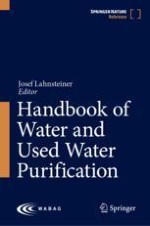Abstract
The main sources of water supply to the south Indian Chennai city are from five major reservoirs in and around the city which depend on monsoon rainfall and hence became not reliable due to the climate change. Chennai city faced several severe droughts in the last 20 years. Depletion of groundwater increased the demand-supply gap multifold. Hence, Government of Tamil Nadu and Chennai Metropolitan Water Supply and Sewerage Board (CMWSSB) resorted to desalination as an alternate source to bridge the demand-supply gap to certain extent and built two 100,000 m3/d desalination plants, one in Minjur commissioned in July 2010 and one in Nemmeli commissioned in February 2013 (Wikipedia, The free encyclopedia. Chennai Metropolitan Water Supply and Sewerage Board. Available via https://en.wikipedia.org/wiki/Chennai_Metropolitan_Water_Supply_and_Sewerage_Board. Accessed 14 Oct 2023 (2023)). CMWSSB’s 100,000 m3/d Nemmeli desalination plant was contracted to be built and operated and maintained for 7 years by VA Tech Wabag. The desalination plant had been a savior when the normal monsoon rains failed. The Nemmeli desalination plant operated at high availability meeting the production target fixed by CMWSSB since 2013.
Based on the seawater study carried out by the consultant MECON, the plant was contracted to be designed for total suspended solids (TSS) of 50 mg/L and total dissolved solids (TDS) of 41,900 mg/L. The plant is fully automatic built with state of the art technology consisting of intake system, upflow filter, disc filters, ultrafiltration (UF) system, RO system, remineralization system, and outfall system. Pressure exchangers that recover brine energy enables plant operation with low specific energy consumption. The plant meets all environmental regulations. Material of construction selected for piping, valves, and pumps ensures minimum or no seawater corrosion and longer plant life.
The plant though was inaugurated by then CM on 22 February 2013, due to teething troubles in achieving treated feedwater flow to RO, few modifications were required and the plant was demonstrated for full capacity operation in the last week of December 2013. The plant was approved by CMWSSB for commercial operation from 8 January 2014. The PGTR was held up awaiting completion of painting of project UF permeate tanks and potable water tanks. The PGTR was completed in the last week of June 2014 and the plant was handed over for O&M from 1 July 2014.
The plant was operating at almost full capacity as per the CMWSSB’s demand until September 2015. The TSS of seawater started increasing above 150 mg/L on few days in a month. Increased TSS in seawater resulted in fouling of disc filters and UF and reducing the UF permeate output by 10–15% which led to operating the RO system at 85,000–90,000 m3/d. Since recurrence of high TSS was persistent and gradually increased in number of occurrences in a month, CMWSSB advised Wabag to improve the pretreatment system to remove the excess TSS and recuperate the plant capability to produce 100,000 m3/d consistently.
Wabag submitted the proposal to CMWSSB to introduce lamella clarifier in the pretreatment system to control the TSS in seawater. The proposal included reuse of disc filter and UF backwash water, by passing them through lamella clarifier and augment the capacity of the plant by 10,000 m3/d with additional seawater recovered. The plant with lamella clarifier commissioned in October 2017 resulted in a robust pretreatment system and was able to operate successfully at almost full capacity until December 2019, meeting the demand from the client CMWSSB. During the Piety cyclone, in December 2018, the plant was able to operate with seawater TSS up to 1478 mg/L. The lamella clarifier was able to bring down the TSS in seawater from 1478 to <30 mg/L.
Since February 2019, the plant is faced with a challenge of operating with seawater having high COD/TOC and light white particles.
The paper presents the salient design features and the operating experience of the Nemmeli desalination plant, modifications carried out, along with the factors influencing the Capex and Opex of a SWRO desalination plant.
